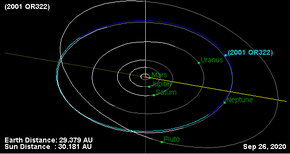(612243) 2001 QR322, prov. designation: 2001 QR322, is a minor planet and the first Neptune trojan discovered, by American astronomer Marc Buie of the Deep Ecliptic Survey at Cerro Tololo Observatory in Chile on 21 August 2001.[1][6] It orbits ahead of Neptune at its L4 Lagrangian point and measures approximately 132 kilometers (82 miles) in diameter.[2][4]
 | |
| Discovery[1] | |
|---|---|
| Discovered by | M. W. Buie (DES) |
| Discovery site | Cerro Tololo Obs. |
| Discovery date | 21 August 2001 |
| Designations | |
| (612243) 2001 QR322 | |
| 2001 QR322 | |
| Neptune trojan · L4[2] TNO[3] · distant[1] | |
| Orbital characteristics[3] | |
| Epoch 4 September 2017 (JD 2458000.5) | |
| Uncertainty parameter 3 | |
| Observation arc | 12.26 yr (4,479 days) |
| Aphelion | 30.968 AU |
| Perihelion | 29.262 AU |
| 30.115 AU | |
| Eccentricity | 0.0283 |
| 165.27 yr (60,363 days) | |
| 86.551° | |
| 0° 0m 21.6s / day | |
| Inclination | 1.3250° |
| 151.75° | |
| 151.11° | |
| Physical characteristics | |
| 132 km[4] | |
| 0.058[4] | |
| 22.5[5] | |
| 8.12[3][2] | |
Other Neptune trojans have been discovered since. A study by American astronomers Scott Sheppard and Chad Trujillo from the Carnegie Institution suggests that Neptune could possibly have twenty times more trojans than Jupiter.[7]
Orbit
edit2001 QR322 orbits the Sun with a semi-major axis of 30.115 AU at a distance of 29.3–31.0 AU once every 165 years and 3 months (60,363 days). Its orbit has an eccentricity of 0.03 and an inclination of 1° with respect to the ecliptic.[3]
Dynamical stability
editEarly studies of the dynamical stability of 2001 QR322, which used a small number of test particles spread over the uncertainties of just a few orbital parameters that were derived from a limited observation arc, suggested that 2001 QR322 is on a remarkably stable orbit, because most test particles remained on trojan orbits for 5 Gyr. Thereafter, the stability of Neptune trojans was simply assumed.[8]
A more recent study, which used a very large number of test particles spread over the 3σ uncertainties in all six orbital parameters derived from a longer observational arc, has indicated that 2001 QR322 is far less dynamically stable than previously thought. The test particles were lost exponentially with a half life of 553 Myr. Further observations can determine whether 2001 QR322's orbit is actually within the dynamically stable or within the unstable part.[8]
The stability is strongly dependent on semi-major axis, with a≥30.30 AU being far less stable, but only very weakly dependent on the other orbital parameters. This is because those with larger semi-major axes have larger libration amplitudes, with amplitudes ~70° and above being destabilized by secondary resonances between the trojan motion and the dynamics of at least Saturn, Uranus, and Neptune. Secular resonances were found not to contribute to the dynamical stability of 2001 QR322.[8]
Numbering and naming
editThis minor planet was numbered and its discoverer determined by the Minor Planet Center on 28 March 2022 (M.P.C. 139893).[1][9] If named, it will follow the naming scheme already established with 385571 Otrera, which is to name these objects after figures related to the Amazons, an all-female warrior tribe that fought in the Trojan War on the side of the Trojans against the Greek.[10]
Physical characteristics
editThe discoverers estimate that the body has a mean diameter of 132 kilometers with a low albedo of 0.058 at an absolute magnitude of 8.12.[4] It has a visual magnitude of 22.5.[5]
References
edit- ^ a b c d "(612243) 2001 QR322". Minor Planet Center. Retrieved 8 April 2022.
- ^ a b c "List of Neptune Trojans". Minor Planet Center. 10 July 2017. Retrieved 4 August 2017.
- ^ a b c d "JPL Small-Body Database Browser: (2001 QR322)" (2013-11-25 last obs.). Jet Propulsion Laboratory. Archived from the original on 1 September 2020. Retrieved 5 August 2017.
- ^ a b c d Johnston, Wm. Robert (2 January 2022). "List of Known Trans-Neptunian Objects". Johnston's Archive.
- ^ a b Lakdawalla, Emily (13 August 2010). "2008 LC15, the first Trojan asteroid discovered in Neptune's L5 point". The Planetary Society. Retrieved 8 April 2022.
- ^ Marc W. Buie. "Orbit Fit and Astrometric record for 01QR322" (2008-07-21 using 26 of 26 observations). SwRI (Space Science Department). Retrieved 3 September 2009.
- ^ "Neptune May Have Thousands of Escorts". Space.com. 30 January 2007. Retrieved 4 September 2009.
- ^ a b c Horner, J.; Lykawka, P. S. (June 2010). "2001 QR322: a dynamically unstable Neptune Trojan?". Monthly Notices of the Royal Astronomical Society. 405 (1): 49–56. arXiv:1002.4699. Bibcode:2010MNRAS.405...49H. doi:10.1111/j.1365-2966.2010.16441.x. S2CID 119241123.
- ^ "MPC/MPO/MPS Archive". Minor Planet Center. Retrieved 8 April 2022.
- ^ "Rules and Guidelines for naming non-cometary small Solar-System bodies – v1.0" (PDF). Working Group Small Body Nomenclature (PDF). 20 December 2021.
External links
edit- (612243) 2001 QR322 at AstDyS-2, Asteroids—Dynamic Site
- (612243) 2001 QR322 at the JPL Small-Body Database